

Lithographs from M. E. Descourtilz’s *Atlas des Champignons* (1827) On the topic of danger, Descourtilz himself led a curious life, working as a physician, botanist, and inadvertent historiographer of the Haitian Revolution.
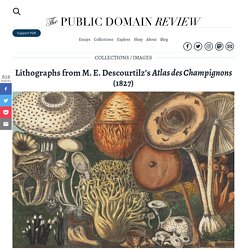
His 1809 Voyages d’un naturaliste chronicles, among other adventures, a trip from France to Haiti in 1799 in order to secure his family’s plantations. Despite having been issued a passport, he was arrested soon after his arrival by Jean-Jacques Dessalines, under Toussaint Louverture’s command, and only escaped death due to his medical training and the intervention of Mme Dessalines, the later Empress of Haiti: Marie-Claire Heureuse Félicité Bonheur. He spent four years in Haiti, serving against his will as a physician to the revolutionary forces. While he “was mindful to behave in a manner appropriate to the new economic and racial order”, writes Philippe R.
Girard, Descoutilz remained highly critical of independence and in support of reconquest. Search: Magnolia. Botanical Illustrations. Soon is spring. Artwork by @mrs_heberling and featured in @NewPhyt, @Ecology_Letters, @Botanical_ APPS, and most recently, my office bulletin board that I rarely see anymore. Illustrations of plant-root systems from 1919. In 1919, the American biologist John Ernest Weaver published The Ecological Relations of Roots, a study of the root-systems of desert plants.
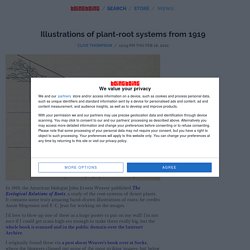
It contains some truly amazing hand-drawn illustrations of roots; he credits Annie Mogensen and F. C. Jean for working on the images. I'd love to blow up one of these as a huge poster to put on my wall! What is botanical art? How do you create botanical art?
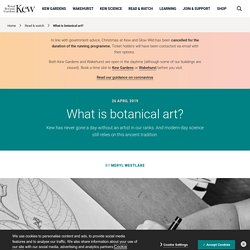
The process of creating a plate is collaborative and scientific. Together, the scientist and the artist go through a long discussion about the specimen, and which details are essential to bring out that will form part of the record, and a reference for other scientists. The artist will decide whether to use pen and ink, or watercolour and their initial sketches. Lucy says, ‘A specimen could come to us bent, folded or misshapen. This is an excerpt of the video (it has sound). The whole video here Filmed at the Linnean Society. Thnx to Elaine Charwat & @isacharmant. Narration based on interviews with Claire Banks & Mark Watson. Narrated by Benjamin Cook. Filmed by Christof.
Frances Sargent Osgood and the Language of Flowers: A 19th Century Literary Genre of Floriography and Floral Poetry. Cover.

Osgood, Frances Sargent (editor). The Floral Offering, A Token of Friendship (1847). Contributed in BHL from Chicago Botanic Garden, Lenhardt Library. Digitization sponsored by the National Endowment for the Humanities (NEH). The Language of Flowers genre is at the intersection of botany, horticulture, natural history, art, poetry, and women’s studies. Some stunning plates from John Martyn's Historia Plantarum Rariorum (1728-1738) @theULSpecColl CCF.47.34. The plates were funded by botanists including Hans Sloane, George Clifford, John Wilmer, and Stephen Hales. Many relate to specimens in @CUHerb. Artists in Edwards’s Botanical Register. Edwards’s Botanical Register was a serial publication consisting of 19 volumes, plus an appendix that ran from 1829-1847 and was edited by John Lindley (1799–1865).

This series was preceded by The Botanical Register, which was started and edited by Sydenham Teast Edwards (1768-1819) and ran from 1815-1828 for a total of 14 volumes. Volumes 15 through 32 of Edwards’s Botanical Register have hundreds of beautiful illustrations that were printed from copper engravings; volume 33’s illustrations were produced from lithographs and hand-colored. Along with several others, both Lindley and Edwards produced illustrations for this series. Like many natural history works, the artists are often uncredited in the actual text of Edwards’s Botanical Register, so determining the creator of the illustration requires careful examination of signatures on the individual plates, as well as research in reliable secondary sources.
Botanical illustration is becoming endangered, but the job is essential. Illustrations from the golden age of botanical art. All of which explains why the discovery of an album of 69 botanical illustrations by Lady Maria Compton, Marchioness of Northampton (1766-1843), her teacher Margaret Meen (circa 1755-1824) and her niece Emma Smith (1801-1876) — who later married Jane Austen’s nephew — is such a rare find.

‘We know very little about these women, so this is a valuable record of three remarkably talented painters,’ says Kishor. The album, which is offered online in the 300 Years of British Drawings sale until 8 December, has been in the Compton family for more than 200 years. Illustration and Representation — Dumbarton Oaks. In the unsigned preface to Franz Bauer’s Delineations of Exotick Plants Cultivated in the Royal Garden at Kew (1796), Joseph Banks (1743–1820) wrote of the plates, which are accompanied by no text except their Linnaean names: It will appear singular at first sight, that engravings of plants should be published without the addition of botanical descriptions of their generic and specific characters; but it is hoped that every botanist will agree, when he has examined the plates with attention, that it would have been a useless task to have compiled, and superfluous expense to have printed, any kind of explanation concerning them; each figure is intended to answer itself every question a botanist can wish to ask, respecting the structure of the plant it represents; the situation of leaves and flowers are carefully imitated, and the shape of each is given in a magnified, as well as in a natural size.
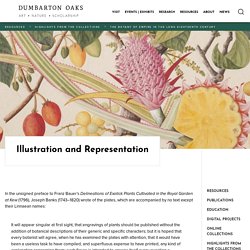
How did people see plants? If I am not deceived by my own passion . . . Bleichmar, Daniela. RHS Lindley Library – Digital collections.
RHS Lindley Library – Digital collections. Hideo Horikoshi, Chrysanthemum × morifolium ‘Edo’ (Chrysanthemum) Watercolour on paper, 2016-2017 © Hideo Horikoshi The Edo-giku chrysanthemum date from the early 1800s.

Hideo Horikoshi studied these classical Japanese flowers at the National Museum of Japanese History and the Shinjuku Gyoen National Garden. He completed his painting over two growing seasons, a year apart. He beautifully captures how the flowers’ petals twist as they mature. Let's Talk About Botanical? Asian. National Gallery of Ireland. Watch this illustrated talk by Alexandra Caccamo, Librarian at the National Botanic Gardens, who discusses the work of Lydia Shackleton and Alice Jacob, specifically their paintings of orchids.
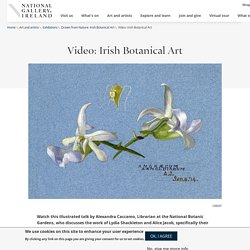
Both artists feature in our exhibition Drawn from Nature: Irish Botanical Art. Drawn from Nature celebrates three centuries of Irish botanical art. The exhibition includes drawings, watercolours, prints, and illustrated publications dating from the 1700s to the modern day. The backgrounds, motivations, and methods of the artists exhibited are diverse. Yet all are connected by a shared desire to observe, record, and advance our knowledge of the natural world. Oak Spring Garden Foundation - Introducing Fantastic Flora.
Plants are much more than décor for your desk, or greenery for your lawn.

They are diverse, living beings that serve countless critical roles within our world. Humans rely on plants for everything from food, to medicine, to providing us with beauty and creative inspiration, but their value far exceeds these uses. Plants are crucial to all life on earth, and understanding their role in complex natural systems – and their amazing ability to adapt and survive in a changing world - can help us provide a better future for our planet. Sparking public dialogue about plants and the environment is a major part of the Oak Spring Garden Foundation’s mission, and we are excited to announce the launch of a free, digital educational exhibit that features the fascinating world of plants. Fantastic Flora blends art, culture, history, and science to explore the role of plants in both human history and the natural world. Potato watercolors. Close Watercolors of potato plants, approximately 1820. ecb00003.
Botany Libraries, Economic Botany Library of Oakes Ames, Harvard University. A Calcutta botanical drawing of Hamiltonia suaveolens with an interesting provenance. Henry Noltie Some years ago, as part of the barter economy, I acquired a handsome, but all but empty, early nineteenth-century album, its calf spine lettered in gilt ‘CHINESE PAINTINGS’. The binding is a luxurious one, of small-folio size, with marbled boards and olive-green, watered-silk endpapers. Tipped onto its flyleaf is a later, supplementary sheet signed with the names Katherine Amelia and Elizabeth Margaret Hibbert and the date 21 August 1845.
On his exile to Elba, Napoleon vowed he’d return to Paris the next year, just as his favourite flower, the violet, did each spring. Here, Canu celebrates that return in March 1815 by hiding silhouettes of Napoleon, his son & 2nd wife Marie Louise in b. The Old Operating Theatre Museum. Uvae ursi - Achostaphylos - Bearberry a.k.a. (of old) - ‘Arbutus’ ‘The Bear’s Grape’. Edible Plants from the Americas. It’s here at last! Happy First Day of Spring!... Royal Botanic Gardens, Kew : The Wallich Collection. Henry G. Gilbert Nursery and Seed Trade Catalog Collection : Free Texts : Free Download, Borrow and Streaming. Cover title Topics: Nursery stock Pennsylvania Catalogs, Flowers Catalogs, Bulbs (Plants) Catalogs Caption title Topics: Seeds Catalogs, Seed industry and trade Ohio Columbus Catalogs, Vegetables Ohio Columbus Catalogs,...
Includes index Topics: Seeds Catalogs, Nursery stock Catalogs, Gardening Equipment and supplies Catalogs, Flowers Seeds... Dr Shirley Sherwood shares her insights on modern botanical art. Lichen. Water-color sketches of plants of North America and Europe v.9. Botanical illustration is becoming endangered, but the job is essential. Wageningen University & Research - Image Collections - Wageningen University & Research - Image Collections.
Late 17c Chinese Drawings of Plants (Cunninghame?) Botany. Herbals - BOTANICAL ART & ARTISTS. TimelineJS Embed. TimelineJS Embed. Belgique horticole v.26. UW-Milwaukee Special Collections. Millions of Free Botanical Illustrations from the Biodiversity Heritage Library. French Savants of Napoleon's Egyptian Expedition Collection. The people and plants shaping modern medicine - Oak Spring Garden Foundation. Gallica. Magnifique planche de botanique japonaise créée vers 1876 du @MuseeEducation à découvrir dans la carte blanche donnée à Arnaud Nebbache pour #LaRonde : goût de l'ailleurs et goût des sciences...… An interview with William Dalrymple, by Mark Rappolt / ArtReview. This December, the Wallace Collection in London hosts Forgotten Masters: Indian Paintings for the East India Company, curated by the award-winning historian, writer and curator (and cofounder of the annual Jaipur Literary Festival) William Dalrymple.
The exhibition, which roughly spans the years between 1770 and 1840, is billed as the first in Britain dedicated to the Indian artists who were commissioned by British patrons associated with the East India Company, artists whose work (much of which was destined for export to Europe) has been generally grouped, by art historians and curators, under the umbrella term ‘Company Painting’ rather than credited to individuals. Moreover, the exhibition attempts to argue that these individuals deserve a place in the history of Indian art more than they merit a place in the history of colonialism.
William Dalrymple: Correct. The East India Company was very different in so many ways from the Raj. Forgotten Masters: Indian Painting for the East India Company - The Wallace Collection. Harvard Botanical Illustrations - CURIOSity Digital Collections. Colored and uncolored images in 16th–17th-century plant books. What is botanical art? Incredible 19th-Century Botanical Catalog Put Online and Made Interactive. Making of the Illustrations of the Natural Orders of Plants - C82: Works of Nicholas Rougeux.
Illustrations of the Natural Orders of Plants. The Pomological Watercolors: A Collection of Watercolor Fruit Paintings. Medicinae Plantae Healing plants through time. Why the USDA Hired Artists to Paint Thousands of Fruits. Collection: Conrad Loddiges & Sons orchid watercolors. Medicinal plants in the ‘Elegancies of Jamaica’, an 18th century manuscript – Herbal History Research Network. Passionate pioneers – increasing access to botanical artwork by women artists. 1804 - Icones plantarum medico-oeconomico-technologicarum cum earum fructus ususque descriptione =
Guest blog: Kew Curator Lynn Parker describes the confluence of science and art in plant drawings – Cultivating London. Lost Grains and Forgotten Vegetables from Japan: the Seikei Zusetsu Agricultural Catalog (1793–1804) Marg. Volume 70 Number 2. Botanical Drawings made in Nepal for Nathaniel Wallich in 1821 by Vishnupersaud and Gorachand. Chiba University launched Open Access Resource 'c-arc' Interleaving in the RBGE Collections, Part 2: British Marine Algae.
Wellcome Collection: botany. 1 - Ueber den Pollen, Vol. 1 - Les fleurs animees. Fossil images. What is botanical art? DSI - Database of Scientific Illustrators. World Wide Exhibition of Botanical Art 2018 - Botanical Art & Artists. Plant Illustrations Website. Plantillustrations.org search cacti / succulents. How the RHS Colour Chart is used.
Eighteenth-Century Botanical Illustrations. OPLL16 for website JUN2018. Association of British Botanical Artists. Plant Resources I: Plant Image Bank - AoBBlog. Women Botanical Artists. Women's Work. Passionate pioneers: increasing access to botanical artwork by women artists. Women in Historical SciArt. Women Illustrators In Natural History. The Art of the Rose. BioLib Online Library of Biological Books. Anna Laurent » Art + Botany. DSI - Database of Scientific Illustrators. Library of Congress Botanical Images. News – Draw In Nature Studio. The Nine Herbs Charm. The Botanical Eye. Study Room resource: Botanical illustration. Wellcome Collection. A Brief History of Mycological Illustration. Botanical Artists in Africa - Botanical Art & Artists.
South African Botanical Illustrators. Illustrations of Southern Africa flora, Global Plants on JSTOR. UCT Libraries Digital Collections.